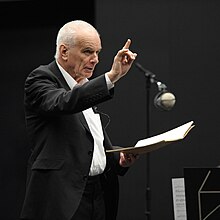Symphony No. 5 (Davies)
| Symphony No. 5 | |
|---|---|
| by Peter Maxwell Davies | |
 The composer in 2012 | |
| Based on | Davies' Chat Moss (1993) |
| Recorded | 1995 (issued) |
| Premiere | |
| Date | 9 August 1994 |
| Location | Royal Albert Hall, London |
| Conductor | Peter Maxwell Davies |
| Performers | Philharmonia Orchestra |
The Symphony No. 5 was composed by
Character and materials
The form of the symphony (along with those of its predecessors) owes a great debt to the symphonies of Sibelius, in this case particularly the Seventh.[1][2] However, its sense of space, "less architectural than that of the previous symphonies, is a significant new departure, allowing a more relaxed attitude toward musical objects: closer to the Mahlerian aesthetic than at any time since the 1960s".[3] Davies has also cited the often canonic modal counterpoint of Sibelius's Sixth Symphony as an influence, and Sibelius's tone poem En saga has also been mentioned as a possible source of inspiration.[4]
Instrumentation
The symphony is scored for 2
Analysis
On the model of Sibelius's Seventh, the symphony suggests the traditional four-movement form, but is cast in a single movement. It nevertheless forms an "archipelago of 34 sections of various length".
Discography
- Peter Maxwell Davies: Symphony no. 5; Chat moss; Cross Lane fair; Five Klee Pictures. Philharmonia Orchestra; BBC Philharmonic; Sir Peter Maxwell Davies, conductor. CD recording. Collins Classics 14602. [UK]: Lambourne Productions, 1995.
References
- ^ a b Beecroft 1994, 2.
- ^ Pruslin 1996.
- ^ Beecroft 1994, 5.
- ^ Warnaby 1995, 34.
- ^ Anon. n.d.
- ^ Davies 1995.
- ^ Warnaby 1995, 33.
- ^ Beecroft 1994, 3.
Sources
- Anon. (n.d.). "Maxwell Davies, Peter: Symphony No. 5 (1994)". Boosey & Hawkes.
- Beecroft, Julian. 1994. "Maxwell Davies's Fifth Symphony". Tempo, new series, no. 191 (December): 2–5.
- Davies, Peter Maxwell. 1995. Composer's note". In the score of Symphony No. 5. Hawkes Pocket Scores 1288. London: Boosey & Hawkes. Note reproduced on Boosey & Hawkes website (Accessed 27 December 2011).
- Pruslin, Stephen. 1996. "Symphony No. 5 (1994)". http://www.maxopus.com/work_detail.aspx?key=262 MaxOpus Website (Accessed 27 December 2011).
- Warnaby, John. 1995. "Maxwell Davies's 'The Beltane Fire' and Fifth Symphony". Tempo, new series, no. 194 (Italian Issue, October): 33–35.
Further reading
- Adlington, Robert. 1996. "Grammar-School Boys". The Musical Times 137, no. 1835 (January): 35–37.
- Jones, Nicholas. 2002. "Peter Maxwell Davies's Basic Unifying Hypothesis: Dominant Logic". The Musical Times 143, no. 1878 (Spring): 37–45.
- McGregor, Richard, ed. (2000). Perspectives on Peter Maxwell Davies. Aldershot Hants., Burlington Vermont, Singapore, Sydney: Ashgate Publishing. ISBN 1-84014-298-7.
- McGregor, Richard. "Max the Symphonist". In McGregor (2000), pp. 115–137.
- Warnaby, John. "Peter Maxwell Davies's Recent Music, and Its Debt to His Earlier Scores". In McGregor (2000), pp. 75–92.
- Whittall, Arnold. "'A Dance of the Deadly Sins': The Beltane Fire and the Rites of Modernism". In McGregor (2000), pp. 138–158.
- Sutcliffe, Tom. 1994. "Prom Premiere; Majestic Max". The Guardian (10 August): T4.
- Warnaby, John. 2001. "Davies, Peter Maxwell". The New Grove Dictionary of Music and Musicians, 2nd edition, edited by Stanley Sadie and John Tyrrell. London: Macmillan.
- Whittall, Arnold. 1994a. "The Bottom Line. Arnold Whittall Goes in Search of the 'Great Mystery' of Maxwell Davies, Who Celebrates His 60th Birthday This Month". The Musical Times 135, no. 1819 (September): 544–550.
- Whittall, Arnold. 1994b. "Comparatively Complex: Birtwistle, Maxwell Davies and Modernist Analysis". Music Analysis 13:139–159.
